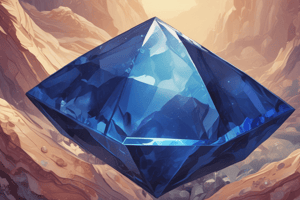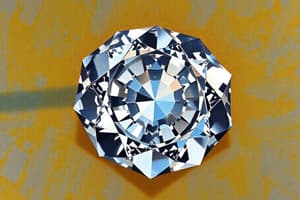Podcast
Questions and Answers
What is the most important factor to consider when judging a gemstone's beauty and value?
What is the most important factor to consider when judging a gemstone's beauty and value?
- Examining its cut and proportions
- Checking its geographic origin
- Comparing it with others of its own species or variety (correct)
- Comparing it with other gemstones of different species
Why is it crucial to know a gem's identity before grading it?
Why is it crucial to know a gem's identity before grading it?
- To accurately assess its quality and characteristics (correct)
- To understand its emotional significance
- To determine its market value
- To identify its geographic origin
What is generally more valued in gemstone varieties?
What is generally more valued in gemstone varieties?
- Mixed hues
- Pure hues (correct)
- Dark tones
- Saturated hues
Why should you avoid using trade terms that imply a gem's geographic origin?
Why should you avoid using trade terms that imply a gem's geographic origin?
How can the way a gem is cut affect its appearance?
How can the way a gem is cut affect its appearance?
Why do cutters often compromise on proportions when cutting highly valuable rough?
Why do cutters often compromise on proportions when cutting highly valuable rough?
What can be a result of cutting compromises that save weight?
What can be a result of cutting compromises that save weight?
Why do larger stones tend to appear more saturated than smaller stones?
Why do larger stones tend to appear more saturated than smaller stones?
What is the main goal of the cutter when cutting a gemstone?
What is the main goal of the cutter when cutting a gemstone?
Why do some gemstone species only reach fine color in large sizes?
Why do some gemstone species only reach fine color in large sizes?
When comparing gemstones, why is it important to compare them within their own species or variety?
When comparing gemstones, why is it important to compare them within their own species or variety?
What is the purpose of using comparison stones or color samples when buying gemstones?
What is the purpose of using comparison stones or color samples when buying gemstones?
Why are consistent procedures important when grading colored stones?
Why are consistent procedures important when grading colored stones?
What is the relationship between a gem's tone and its saturation level?
What is the relationship between a gem's tone and its saturation level?
Why do some gemstones appear more saturated when cut into larger stones?
Why do some gemstones appear more saturated when cut into larger stones?
What is the consequence of cutting compromises that save weight?
What is the consequence of cutting compromises that save weight?
What is the reason for cutters to compromise on proportions when cutting valuable rough?
What is the reason for cutters to compromise on proportions when cutting valuable rough?
Why do some gemstone species share similar hue and saturation ranges?
Why do some gemstone species share similar hue and saturation ranges?
What is the main goal of the cutter when cutting a gemstone?
What is the main goal of the cutter when cutting a gemstone?
Why do some gemstones only reach fine color in large sizes?
Why do some gemstones only reach fine color in large sizes?
Flashcards are hidden until you start studying
Study Notes
Evaluating Colored Stones
- Judge a gemstone's beauty and value by comparing it to others of the same species or variety.
- Use comparison stones or color samples when you can't control the lighting conditions.
Grading Colored Stones
- Know a gem's identity before grading it.
- Consistent procedures are crucial when grading colored stones.
- Pure hues are generally more valued than mixed hues in many gemstone varieties.
Characteristics of Attractive Colored Stones
- Attractive colored stones tend to have highly saturated hues and medium to medium-dark tone.
- Hues with very light or very dark tone usually don't reach the same high levels of saturation as those with medium tone.
The Impact of Cutting on Colored Stones
- The way a gem is cut can dramatically affect its face-up color.
- Larger stones can appear more saturated than smaller stones cut from the same rough.
- The cutter's main goal is to produce a stone with the highest possible value.
Cutting Compromises
- Cutters often compromise on proportions to save weight and avoid loss of money when rough is very valuable.
- Cutting compromises can cause extinction, windows, or both.
- Many defects in colored stone proportions are compromises made by the cutter to produce economically viable gems.
Size and Color in Colored Stones
- Some stones reach fine color only in large sizes, while others only in small sizes.
- Larger stones can appear more saturated than smaller stones cut from the same rough.
Shared Hue and Saturation Ranges
- Many gemstone species share some of the same hue and saturation ranges.
Evaluating Colored Stones
- Judge a gemstone's beauty and value by comparing it to others of the same species or variety.
- Use comparison stones or color samples when you can't control the lighting conditions.
Grading Colored Stones
- Know a gem's identity before grading it.
- Consistent procedures are crucial when grading colored stones.
- Pure hues are generally more valued than mixed hues in many gemstone varieties.
Characteristics of Attractive Colored Stones
- Attractive colored stones tend to have highly saturated hues and medium to medium-dark tone.
- Hues with very light or very dark tone usually don't reach the same high levels of saturation as those with medium tone.
The Impact of Cutting on Colored Stones
- The way a gem is cut can dramatically affect its face-up color.
- Larger stones can appear more saturated than smaller stones cut from the same rough.
- The cutter's main goal is to produce a stone with the highest possible value.
Cutting Compromises
- Cutters often compromise on proportions to save weight and avoid loss of money when rough is very valuable.
- Cutting compromises can cause extinction, windows, or both.
- Many defects in colored stone proportions are compromises made by the cutter to produce economically viable gems.
Size and Color in Colored Stones
- Some stones reach fine color only in large sizes, while others only in small sizes.
- Larger stones can appear more saturated than smaller stones cut from the same rough.
Shared Hue and Saturation Ranges
- Many gemstone species share some of the same hue and saturation ranges.
Studying That Suits You
Use AI to generate personalized quizzes and flashcards to suit your learning preferences.




